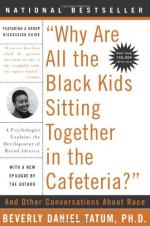
|
| Name: _________________________ | Period: ___________________ |
This test consists of 5 short answer questions, 10 short essay questions, and 1 (of 3) essay topics.
Short Answer Questions
1. What was a landmark decision of the US Supreme Court that declared state laws establishing separate public schools for black and white students unconstitutional?
2. When was Assimilation Blues: Black Families in a White Community published?
3. Native American groups constitute around how many people, according to the author?
4. What is the third of five stages that whites pass through in dealing with race, according to the author in Part III, Understanding Whiteness in a White Context, Chapter 6, The Development of White Identity?
5. The term "affirmative action" first appeared in Executive Order 10925, which was signed by what American President?
Short Essay Questions
1. What is the impact of the "one-drop" rule in history, as discussed in Part IV, Beyond Black and White, Chapter 9, Identity Development in Multiracial Families?
2. How is biracial development approached by the author in Part IV, Beyond Black and White, Chapter 9, Identity Development in Multiracial Families?
3. How does the author describe differences between males and females in biracial identity formation in Part IV, Beyond Black and White, Chapter 9, Identity Development in Multiracial Families?
4. How does the author suggest that Whites deal with their struggle with Whiteness positively in Part III, Understanding Whiteness in a White Context, Chapter 6, The Development of White Identity?
5. What are the advantages of affirmative action, according to the author in Part III, Understanding Whiteness in a White Context, Chapter 7, White Identity and Affirmative Action?
6. What does Beverly Tatum believe regarding racial dialogue in America, as discussed in Part V, Breaking the Silence, Chapter 10, Embracing a Cross-Racial Dialogue?
7. How does the author assert whites learn about racism in Part III, Understanding Whiteness in a White Context, Chapter 6, The Development of White Identity?
8. How does the author suggest we as individuals seek the courage to open racial dialogues in Part V, Breaking the Silence, Chapter 10, Embracing a Cross-Racial Dialogue?
9. What leads to silence regarding racial dialogue, according to the author in Part V, Breaking the Silence, Chapter 10, Embracing a Cross-Racial Dialogue?
10. In Part IV, Beyond Black and White, Chapter 8, Critical Issues in Latino, American Indian, and Asian Pacific American Identity Development, Tatum addresses what element as drawing together minorities?
Essay Topics
Write an essay for ONE of the following topics:
Essay Topic 1
Discuss the period of history when the author studied at university and the racial climate in America during this time. How did this affect the author's racial identity development?
Essay Topic 2
Define and discuss the strategies of diffusion, foreclosure, moratorium and achievement in racial identity development. How do these stages relate to self-segregation?
Essay Topic 3
Discuss the Nation of Islam, Christianity, and other religions and their impact on racial identity development. Why does the author assert black men are drawn to the Nation of Islam?
|
This section contains 946 words (approx. 4 pages at 300 words per page) |

|




